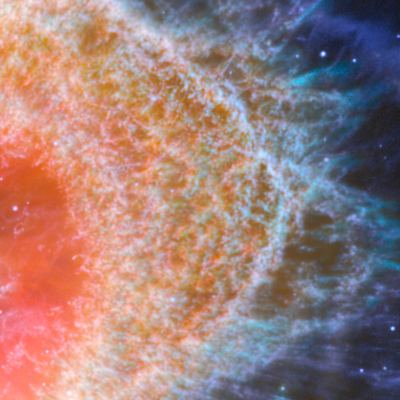When the Sun Dies, it Could Produce a Fantastic Ring in Space, Like This New Image From JWST
By Brian Koberlein
Planetary nebulae were first discovered in the 1700s. Legend tells us that through the small telescopes of the time, they looked rather planet-like, hence the name. Real history is a bit more fuzzy, and early objects categorized as planetary nebulae included things such as galaxies. But the term stuck when applied to circular emission nebulae centered around a dying star. As new observations show, planetary nebulae have a structure that is both simple and complex.
Planetary nebulae are the remnants of stars like our Sun. When stars of about 1 – 8 solar masses near their end of life, they heat up and cast off their outer atmosphere in an expanding sphere. The exposed underlayer of the star then bathes the nebula in ultraviolet radiation, causing the nebula to ionize and glow. While most planetary nebulae are spherical, many have dual lobes or some other asymmetry. While the process can be simple, stellar rotation and magnetic fields can craft an menagerie of structures.
The Ring Nebula is perhaps the most archetypal planetary nebula. It’s just 2,200 light-years away, and bright enough to be seen with a pair of binoculars. Also known as M57, it is a popular target for amateur astronomers. Recently the James Webb Space Telescope (JWST) captured images of the Ring Nebula using both its Near-Infrared Camera (NIRCam) and its Mid-InfraRed Instrument (MIRI), and the results show incredible details.

Both high-resolution images show how the ring portion of the nebula is filled with clumps of hydrogen gas. Astronomers have identified more than 20,000 clumps within the ring, each about as massive as the Earth. Both images also show spikes of gas radiating away from the ring. These are thought to be trails of complex molecules that can only form in dark regions of space. The spikes indicate where the inner globules cast shadows that allow molecules to form without the disruption of ultraviolet light.
The MIRI image in particular also shows concentric arcs of gas in the outermost region of the nebula. This indicates that the star went through cycles of heating and cooling before a final heating period cast off the bulk of its atmosphere. Based on the spacing of these arcs, the cycles occurred every 280 years. This cycling behavior is unusual because there is no nuclear process that would produce it. Instead, astronomers speculate that the central star has an unseen companion orbiting it at a distance roughly that of Pluto from the Sun.
We still have much to learn from these new observations, but it is clear that these nebulae are the result of a complex stellar dance of heat and light. When the time comes for our Sun to become a planetary nebula, we can be sure it will not go quietly into the cosmic night.
Reference: “Webb Reveals Intricate Details in the Remains of a Dying Star.”
The post When the Sun Dies, it Could Produce a Fantastic Ring in Space, Like This New Image From JWST appeared first on Universe Today.

August 23, 2023 at 12:25AM
via Universe Today read more...

Post a Comment